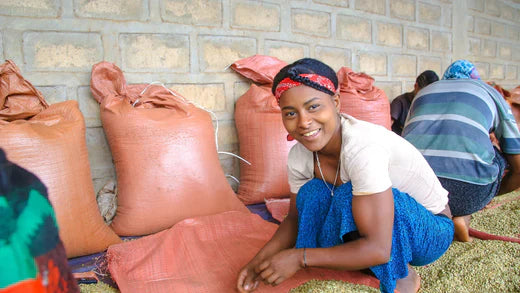Coffee enthusiasts are always on the lookout for the next unique and exciting coffee experience. Gesha coffee is one such experience. It is a rare and exclusive coffee with a distinct flavor profile, high antioxidant capacity, and limited supply. In this blog post, we'll examine the background and traits of Gesha, the distinctions between varieties and cultivars, and why coffee lovers place such a high value on Gesha. We will also discuss how to make Gesha coffee at home.
In a previous blog post, we discussed the differences between the two main commercial coffee species: C. arabica and C. canephora, also known as Robusta. We mentioned that different arabica cultivars produce different taste profiles and have different propensities to develop different levels of nutrients.
In November, we came across a well-known and exclusive cultivar on the cupping table of one of our farming partners, Mildred Muñoz of Finca Santa María in Colombia. The cultivar is known as C. arabica "Gesha," and it is a rare, highly sought-after coffee known for its distinct taste profile and complex flavor. Purity is particularly interested in Gesha because well-farmed, healthy Gesha is known to be high in chlorogenic acid (CGA), a polyphenol antioxidant with numerous chlorogenic acid health benefits.

Among other things, CGA has been linked to improved glucose metabolism, a lower risk of cardiovascular disease, and reduced inflammation. This Gesha from Finca Santa María not only had wonderful fragrance, aromas, and flavors, but when we sent it to the Federal University of Rio de Janeiro's Department of Nutrition, their lab was surprised to see how remarkably high it tested for CGA, even after roasting (3.2 grams of CGA per 100 grams of coffee).
This coffee is especially exciting for us because it advances our research into coffee varieties and cultivars and demonstrates how we can produce the healthiest coffees using natural and regenerative organic practices. Several years ago, Mildred made the decision to have only women manage Finca Santa María, her 75-acre family farm in Aratoca, Santander, Colombia. Currently, 22 women (all of whom are heads of household) run the farm, which has the Con Manos de Mujer seal of approval, and these women collectively decide on everything from leadership to quality control.

Finca Santa María is part of the La Pradera family of farms, owned by Mildred and her husband, Oscar Daza. Their biodynamic practices are innovative, and whenever we visit, Oscar has created new systems both in the land and in the processing equipment that is taking healthy coffee to the highest levels we have encountered to date. They have various cultivars growing, and each coffee tests exceptionally well in the lab. This is why they have been partners with Purity Coffee® for several years.
Let's take a step back and define the difference between varieties and cultivars.
Varieties primarily occur in nature, and the majority of varieties are true to type: Seedlings grown from a variety will have the same characteristics as the parent plant grown in natural conditions (such as in Ethiopia's wild forests). The term "cultivar," which means "cultivated variety," refers to specific plants that humans consciously selected and cultivated because they were the healthiest or had unique traits. Sharp-eyed farmers find some cultivars as the result of plant mutations, but other cultivars might be crossbreeds between two different plants.
Hybrids are manually crossed in the field and should not be confused with genetically modified organisms (GMOs), which are created using high-tech methods such as gene splicing, sometimes combining genes from different species to yield organisms that could not occur in nature. Many cultivars must be propagated vegetatively via cuttings, grafting, and even tissue cultures because seed propagation frequently produces something different than the parent plant.
Some horticulturists argue that most coffees on the market today should be referred to as "cultivars" because farmers selected them for their useful characteristics and purposefully planted them. Although people still refer to a type of plant species as a "variety" in communication, it is usually a "cultivar."
One final clarification: many people use the term "varietal" to mean "variety" or "cultivar." Simply put, "variety" is a noun, and "varietal" is an adjective ("varietal coffee" is correct, not simply "varietal"—substitute any adjective, and you'll see the problem). However, the nominalization of the adjective seems to have taken hold throughout the internet.
The History of Gesha Coffee
Gesha coffee is a variety of coffee that originated in the Gori Gesha forest in Ethiopia and was selected for cultivation in the 1930s. Gesha is a district in the Keffa Zone of Ethiopia's Southwest Region. At the time, an English diplomat sent some plants to Kenya for research, but he labeled and spelled them "Geisha” in his dispatch. From there, it was further developed at a coffee research station in Tanzania before being introduced to Central America as "Geisha" in 1953.
After being recognized for its tolerance to the coffee fungus known as leaf rust, it was distributed throughout Panama (under the spelling "Geisha") in the 1960s. However, some undesirable characteristics of Gesha made it problematic for some producers. Gesha plants tend to have smaller roots and their wood is considered more brittle, but more importantly, they produce fewer fruits while needing more care and labor than other cultivars.
After a few decades, Gesha coffee became increasingly rare and nearly vanished. However, it was rediscovered by coffee farmers in the early 2000s, and one of them entered it in the 2005 "Best of Panama" competition/auction, where it received incredibly high scores and wildly exciting accolades. Along with this resurgence, many in the coffee industry were intent on reverting to the spelling that reflected the origin of the coffee, "Gesha," although in Panama the spelling has become fixed as "geisha."
In 2005, the Panamanian "geisha" also broke the previous record for green coffee auction prices, selling for over $20 per pound when the New York commodity price for coffee was around $1 per pound. Naturally, this resulted in a revival in popularity, which was fueled by previously unheard-of valuations.
In 2019, the Lamastus family sold their award-winning "Panamanian Geisha" coffee for $1,029/lb, and then in 2022 they sold their honey-processed "Geisha" coffee for a staggering $6,034/lb (only 7 pounds total of that lot!).
Gesha is still grown today in several countries and is valued for its distinctive and strong flavors and aromas (such as floral, tea, citrus, or apricot), particularly when the plants are properly cared for at high elevations and processed attentively. In the 2023 US Barista Championship competition, half of the 18 semifinalists used a Gesha coffee, and 4 of the 6 finalists were Geshas (3 of these underwent anaerobic fermentation).
Gesha coffees remain among the most expensive in the world for a variety of reasons, including the following:
-
Rarity:Gesha coffee plants are hard to grow and don't produce a lot of beans, so the beans themselves are pretty rare. Demand for Gesha coffee frequently exceeds supply, resulting in higher prices.
- Labor-Intensive Production: Growing Gesha coffee requires a significant amount of manual labor and specialized knowledge, which raises the cost. The delicate nature of the plants necessitates a particular growing environment, which increases the difficulty and expense of production.
- Popularity: Gesha coffee has gained enormous popularity among coffee lovers due to its reputation as one of the finest coffees in the world. This increased demand has pushed prices even higher.
Introducing: Purity Coffee® Gesha
We value Gesha at Purity because of its high antioxidant capacity. When we visited Colombia in November, we were astounded by the complexity of the Gesha produced by Santa María, as well as the effort that went into bringing out the best in the coffee.
Only coffee cherries with a sugar content greater than 20 degrees Brix were harvested. After that, the Gesha was honey-processed (no actual honey is used, but the beans appear to be coated in honey and smell like honey during the process), and the cherries were then sorted and washed before being sealed in GrainPro bags for anaerobic fermentation for 24 hours. The coffee was then pulped and aerobically dry fermented for 36 hours. The fermented, pulped coffee was then dried for 20 hours before being moved to the marquee to dry an additional 20 days.
In the end, they could only offer us 7 sacks of this coffee because that was all they had in the lot. Yes, as you may have guessed, we couldn’t resist buying it!
We have been planning to create a "gold label" coffee at Purity Coffee® for years, but only if we could find one that had both incredible flavor AND remarkable health benefits. This limited-release Gesha coffee is a true luxury for coffee lovers looking for a one-of-a-kind coffee experience that also meets our high health standards. This prized coffee will go on sale in mid-May. However, due to the extremely limited quantity available, we will prioritize Purity Coffee® subscribers and offer them the first invitations to purchase it. Keep an eye out for our announcement over the next several weeks!
In the meantime, we've included some brewing guidelines for Gesha below. For those of you interested in trying a modified version of professional cupping, our Gesha coffee will come with instructions for a full sensory journey.
Enjoy!
Brewing Tips for Enjoying Gesha Coffee
Clean Your Equipment
The fragrance, aroma, and flavors of Gesha can be delicate and fleeting. Make sure your grinder is free of other coffees. Wipe out the hopper and grind about 10 Gesha beans to "season" the burrs, then discard the grounds before grinding your Gesha coffee to brew. Also, be sure your brewing equipment is clean—use your nose to sniff out any stale odors and get rid of them with vinegar (then get rid of the vinegar!).
Grind JUST before Brewing
Grind only the amount of coffee required for each brew. As a starting point for Gesha, use the grind size you've been using for your other brews—it should require a little adjustment, but it may not. Breathe in the fragrance of the dry coffee as you grind it to see if you can pick out any unique notes. Gesha's complexity includes completely different experiences with each step of preparation.
Use Pure, Clean Water
This is especially important for Gesha because you don't want any foreign odors in the water. Due to a few minerals necessary for the chemistry of brewing, the water shouldn't be distilled. We prefer to use water labeled "spring" or "mountain."
Make Note of your Recipe of Coffee-to-Water
For every 300 ml (or g) of water, start with approximately 16 to 18 g of coffee grounds (or 0.6 oz of grounds per 10 fl. oz. of water). Since Gesha is unique among other coffees, you might prefer it weaker or stronger than your typical cup. Make written notes as you experiment with ratios, timing, and water temperature (don't use rolling-boil—let it cool for a minute, but don't go too cool—198°F to 205°F should do). Most importantly, when brewing the coffee, breathe in the aroma as the water infuses the Gesha grounds—you'll get many volatile aromatics that are only present in the first few moments of extraction. As the coffee steeps, new aromatics will emerge.
Try it Black First
The best way to appreciate the complexity and uniqueness of Gesha is to drink it without sugar or milk. Taste it hot (without burning your mouth), warm, and less hot. Pay attention to any changes in the coffee on each pass. You should find different things throughout the experience. Of course, once you've discovered these things, you can add whatever you want to the Gesha and see what other delicious flavors you can find in it!
In conclusion, Gesha coffee has a distinct flavor profile, a high antioxidant capacity, and a limited supply. We have examined the background and traits of Gesha, the variations between cultivars, and the reasons why coffee connoisseurs hold Gesha in such high regard. It not only provides a unique coffee experience, but it also has numerous health benefits. Supporting farmers who grow Gesha is also critical to the survival of this rare and exclusive coffee. We hope that this article will encourage you to try new kinds of coffee and to appreciate the skill of the farmers who make Gesha.
6 comments








So excited to try!!! Hoping to get updates!! I absolutely love my Purity Coffee!
This discovery and the sourcing honors small ethical farmers. ALL reasons to LOVE at his company and I cannot wait to try GESHA! Thank You for bringing this to us😊
This sounds amazing and I hope I get to try some. Thank you for bringing this to this community.
Thank you for the information and instructions concerning the Gesha coffee. It sounds heavenly with fabulous health benefits to boot! Looking forward to experiencing it.
This is very interesting! I love all the advice and drinking coffee black is a must-do!!! Can’t wait to purchase this Gesha brand!!
Leave a comment